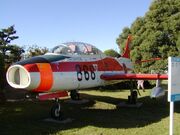| Category. | Statistic. |
|---|---|
| First flight on. | 1958. |
| Retired on. | 2006. |
| Major contractor(s). | Fuji Heavy Industries. |
| Dose it use nukes or cruse missiles. | No. |
| Fight ceiling. | 14,400 m (47,244 ft). |
| Top speed. | 925 km/h (575 mph; 499 kn) at 6,100 m (20,000 ft). |
| VTOL. | No. |
| Range. | 1,300 km (808 mi; 702 nmi) (on internal fuel). |
| Crew. | 2. |
| Nationality(s). | Japan. |
| Fighter Class. | Intermediate trainer and light attack. |
| Rate of climb. | 33 m/s (6,500 ft/min). |
| Links. | http://www.flightglobal.com/pdfarchive/view/1962/1962%20-%201245.html, http://www.faqs.org/docs/air/avf863.html#m6, http://www.faqs.org/docs/air/avf863.html#m6, https://www.flightglobal.com/pdfarchive/view/1962/1962%20-%201245.html, https://en.wikipedia.org/wiki/Fuji_T-1#cite_note-Janes_65_p103-6, https://search.yahoo.com/search?p=Fuji+T-1&fr=yset_chr_cnewtab&type=default, https://images.search.yahoo.com/search/images;_ylt=cnewtab, https://i.gratefulgoose.com/compare.html?q=Fuji+T-Fuji+T-1 and https://www.amazon.co.uk/s/?sl_5pygl5gplb_e |

A T-1B on 7 October, 2006. Author- いたち.

A Fuji Heavy Industries, Ltd.T-1, displayed at Japan Air Self Defense Force Hamamatu AB (2004/10/03). It is in a special paint scheam. Photo by Maryu.
T-1A used a Bristol Siddeley Orpheus Mk 805 turbojet and the T-1B used the Ishikawajima-Harima J3 turbojet.
- The T-1 was the first indigenously designed Japanese jet aircraft to be developed since World War II. It was part of America's plan to start letting Japan make it's own stuff, rather than endlessly buy American stuff.
- The Fuji T-1 was Japan's first jet-powered trainer aircraft.
- Fuji was the successor to the Nakajima Aircraft Company (famous for building several aircraft during WW2, such as the Zero Fighter).
- The first aircraft of Fuji's own design was the T-1 jet trainer.